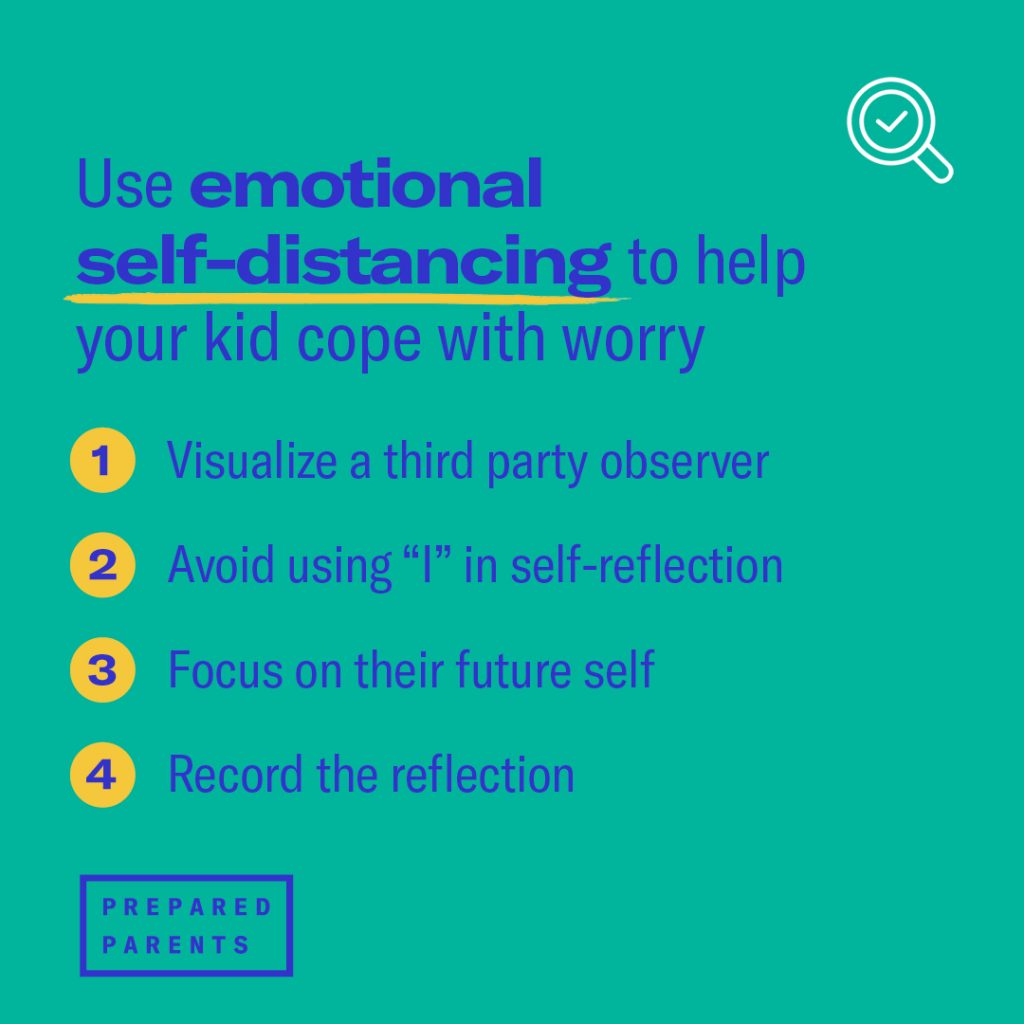Do you remember the last time you had an argument, and how you got caught up in a continuous loop of reflection afterward? Thinking—“then she said that,” “I felt this,” and perhaps “Next time, I will…” Kids do it too.
When a stressful or upsetting event occurs, kids can get caught up in thinking how they were wronged, or how the limits you place on them are unfair, and how that makes them feel.

Both adults and kids use this kind of reflection to process arguments and upsetting events to make sense of them. This sense-making can take the form of positive self-reflection (resulting in lower anxiety levels), or unfortunately, it can lead to worrying (making us feel worse). How can parents help kids pivot away from worry, toward self-regulation and “taking a step back.” Psychologists recommend emotional self-distancing as the single most effective way to process and self-regulate strong emotions
Studies with children and adolescents show that when they step back and view the event from a third-person perspective, they avoid the trap of recounting the distressing event repeatedly and are able to provide objective insight to obtain closure.
Emotional self-distancing is a strategy that teaches us how to self-regulate, one of the 16 Habits of Success that Prepared Parent’s resources are rooted in. The Habits of Success are social and emotional mindsets and behaviors that set kids up for success in school and life. They were developed by educational psychologist Dr. Brooke Stafford-Brizard of education research non-profit Turnaround for Children, in her Building Blocks for Learning Framework.
Every kid needs a set of foundational skills that gives them the mental and emotional security it takes to engage and connect with others. These foundational skills, represented on the first row of the framework, include:
- Attachment: Having a strong bond with an adult who cares about me
- Stress management: Figuring out how to become calm and balanced when situations get stressful
- Self-regulation: Directing and maintaining my attention and emotions
When kids are stressed or emotionally overwhelmed, they’re unable to focus and learn. Healthy development starts with strong parental or caregiver bonds, and is strengthened when our kids learn how to manage stress and emotions, so that they can focus on external goals.
To practice emotional self-distancing with your kid, encourage them to follow these steps:
- Visualize a third-party observer. Younger kids can ask themselves “What did Batman see? What would Batman do?” Older kids can visualize a trusted peer or mentor and ask the same questions.
- Avoid using “I”. Encourage your kid to step out of their own perspective by using pronouns like “her,” “they,” “him,” rather than “I”.
- Focus on their future self. Ask them how they would feel about this event one week or one year from now. This mental time travel directs their attention away from the immediate circumstance and assists with emotional recovery.
- Encourage reflection. As parents, we can listen, ask genuine questions, and help our kids see their own logic and emotion in a situation. Have a reflection conversation by asking:
What do you want from this situation?
What emotions do you have?
What behaviors are you exhibiting?
Put yourself in the other person’s shoes. What do you think their perspective is?
What role can you play in getting to your desired outcome?
Is there anything you need to do to make the relationship right?
“This captures the basic science behind relationship repair with questions prompting each party to put themselves in the shoes of the other, get in touch with their emotions, clearly articulate the facts, and to look for the role they can play in a solution.”
-Diane Tavenner, CEO and co-founder of Summit Public Schools, Prepared author
Prepared author, and co-founder and CEO of Summit Public Schools, Diane Tavenner, says we can ask reflective questions verbally, but we can also ask our kids to reflect in written form—which is particularly useful when helping to mediate a conflict between two kids.
Be attentive to any signs of avoidance, which is merely side-stepping strong emotions or upsetting circumstances, not dealing with them.
You’ll notice that age and practice also play a role in emotional self-distancing. As kids approach adolescence, their prefrontal cortex—critical to self-reflection—matures and this, with additional support provided by caretakers, helps them self-regulate better.

